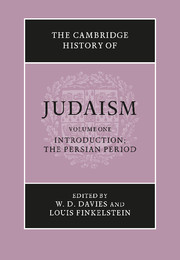Book contents
- Frontmatter
- INTRODUCTION
- THE PERSIAN PERIOD
- 4 The Persian empire and the political and social history of Palestine in the Persian period
- 5 The archeology of Persian palestine
- 6 Hebrew and Aramaic in the Persian period
- 7 The Jewish community in Palestine in the Persian period
- 8 Prophecy and Psalms in the Persian period
- 9 Wisdom literature in the Persian period
- 10 Jewish religious life in the Persian period
- 11 Persian religion in the Achemenid age
- 12 Iranian influence on Judaism: first century B.C.E. to second century C.E.
- 13 The Diaspora
- Bibliographies
- Chronological Table
- Index
- References
7 - The Jewish community in Palestine in the Persian period
from THE PERSIAN PERIOD
Published online by Cambridge University Press: 28 March 2008
- Frontmatter
- INTRODUCTION
- THE PERSIAN PERIOD
- 4 The Persian empire and the political and social history of Palestine in the Persian period
- 5 The archeology of Persian palestine
- 6 Hebrew and Aramaic in the Persian period
- 7 The Jewish community in Palestine in the Persian period
- 8 Prophecy and Psalms in the Persian period
- 9 Wisdom literature in the Persian period
- 10 Jewish religious life in the Persian period
- 11 Persian religion in the Achemenid age
- 12 Iranian influence on Judaism: first century B.C.E. to second century C.E.
- 13 The Diaspora
- Bibliographies
- Chronological Table
- Index
- References
Summary
The function of this chapter is a limited one, confined to the consideration of the small Jewish (Judean) community itself, the sources for our understanding of its history, and an attempted reconstruction of the essential elements of that history in the Persian period. The wider background of the Persian empire and the information available to us regarding the position of the political units within the Palestinian area under Persian rule have been considered in chapter 4. The evidence provided by archeology is set out in chapter 5. Inevitably some points of overlap and of difference of interpretation must appear between the present discussion and what has preceded, especially since at many points there are great problems in the interpretation of the relatively meagre evidence. Nor can the history of the Palestinian community be satisfactorily understood without awareness of its relationship to those in Babylonia and in Egypt; the main stages of the history are associated with new figures who appear from Babylonia, and relationship with one particular Jewish group in Egypt, that of Elephantine, raises questions about both the chronology of the Palestinian community and the way it regarded itself, though no direct allusion to this Egyptian group is to be found in the biblical material. Discussions of these other areas are to be found in chapter 13. Clearly too the internal life of the community cannot be adequately considered without an awareness of its expression in religious writings such as are discussed in the two chapters that follow on ‘Prophecy and Psalms’ and on ‘Wisdom literature’ (chapters 8 and 9); and in the more general treatment of the religious life of the period there must be overlap and some differences of interpretation from what is here indicated (see chapters 10 and 11).
- Type
- Chapter
- Information
- The Cambridge History of Judaism , pp. 130 - 161Publisher: Cambridge University PressPrint publication year: 1984
References
- 3
- Cited by



